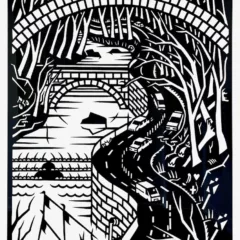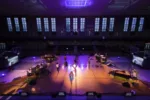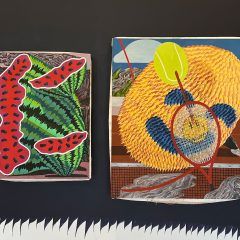“Library” is one of those rare words that held different connotations for me as I made the mystical transition from childhood into maturity. As a child, the small branch of the public library just a few blocks away from my home offered the promise of Reading Rainbow-style journeys into other worlds, bright picture books splattered with enough colors to rival the appeal of a candy store window, and the chance to make friends in any of a number of after-school programs. Once I entered high school, however, “library” quickly became associated with term papers, the echoing halls of silence and dust that characterize the Central Branch, and imposing walls of books stacked high beyond the reach of all but a ladder-equipped librarian. Entering Amze Emmons’ Refugee Reading Room, at Space 1026 through February 26, was like being transported instantaneously back to those easy-to-reach worlds of early childhood.
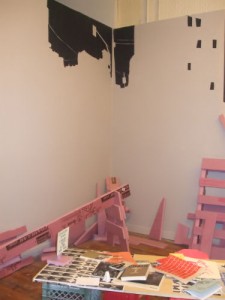
From the outside, Space 1026 looks like the setting for a backroom deal in a heist movie – a graffiti-covered door with caged frame over its window opens out to a steep, wooden staircase littered with newspapers and broom closet supplies. The gallery space, complete with chandelier and faded, green settee, has an air of worn elegance, like a Victorian salon caught at the winding-down point in a time-lapse photography sequence. Emmons’ show, with its pastel colors and modern urban appeal, creates a pleasant contrast that still manages to suit the room, like a brightly-colored cartoon landscape suddenly popping up in the midst of drab reality a la Who Framed Roger Rabbit?
The silhouette of a city landscape, painted in asymmetrical lines worthy of the hand of Dr. Seuss, provides a backdrop to the exhibition. Propped up in corners and flowing over the floor like waste from an abandoned construction site are several wooden-beams, A-Frames and crates painted carnation pink. The sea of pastel debris, an homage to Emmons’ interest in refugee architecture, almost washes over a table that provides the focal point of the show: the “Reading Room Library.” Scattered over this table, constructed of a wooden flatbed propped up on plastic crates, an avalanche of paper products awaited the crush of people arriving for the First Friday opening. Seated on plastic children’s stools or crowded around the table, guests were encouraged to peruse the array of literature, photography and experiments-in-design.
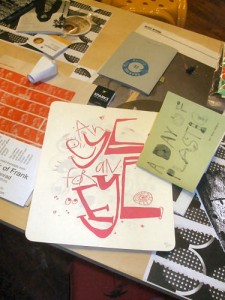
“I think this particular project was heavily influenced by my collaboration on Printeresting, which is a kind of art project/art journalism project that I work on with R.L. Tillman and Jason Urban, and through that I’ve been put in touch with a lot of small press publications,” remarked artist Amze Emmons the night of the opening.
To the right of the library stands a mock-up of a newspaper stand, with white signs reading “FREE” in large, black font hanging along a series of shelves in the back. Included among the free gifts are samples of works from the library, as well as issues of the zine Machete, and various farcical tags, computer printouts, pins and matchbooks.
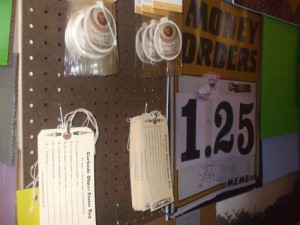
“I guess the big idea of the exhibit is that it’s a kind of gift economy,” Emmons explained. “And rather than just working with people who made zines – there’s poets, there’s cartoonists, there’s illustrators, there’s a lot of different types of creative people who contributed to this. And I’m sort of curious to see what happens if all that stuff is put into conversation.”
From the reaction of the First Friday crowds, whose excited chatter kept a steady background beat echoing across the small space, it seems that Emmons achieved the purpose behind the Refugee Reading Room. As individuals walked away with piles of souvenirs cradled in their arms, it became clear that the conversation would continue beyond the walls of Space 1026, breaking the fourth wall between a gallery and the outside world.
In a sense, Refugee Reading Room is the story of what would happen to a library without walls, plopped casually in the middle of a city street. It offers yet another context in which to view a “library” – as a forum-like space where ideas and individuals can freely come together.



